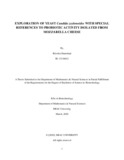| dc.contributor.advisor | Hossain, Mahboob | |
| dc.contributor.advisor | Bhuiyan, Mohammad Nazrul Islam | |
| dc.contributor.author | Shamshad, Ritwika | |
| dc.date.accessioned | 2021-05-22T05:03:03Z | |
| dc.date.available | 2021-05-22T05:03:03Z | |
| dc.date.copyright | 2020 | |
| dc.date.issued | 2020-03 | |
| dc.identifier.other | ID: 15136012 | |
| dc.identifier.uri | http://hdl.handle.net/10361/14410 | |
| dc.description | This thesis is submitted in partial fulfilment of the requirements for the degree of Bachelor of Science in Biotechnology 2020. | en_US |
| dc.description | Catalogued from PDF version of thesis. | |
| dc.description | Includes bibliographical references (pages 59-60). | |
| dc.description.abstract | Yeast strains have significant characteristics based on their nature and abilities to produce food
products, medicines, protein supplements, etc. Candida zeyalanoides is the yeast strain that had
been speculated in this study. This strain was collected from Mozzarella cheese and has an
idiosyncratic nature of having a pink pigment of it. This is least speculated strain, so to identify
some of its certain essences to certain experiments; for instance, its caliber to endure heat stress,
its efficiency to undergo such osmotic stress and the probiotic efficacy of it was done along with
its isolation, characterization. In a state of enduring different parity of temperatures (30°C, 32.5°,
37°C, 40°C and 44°C) the responses were diverse. However, C. zeyalanoides showed optimum
growth at 32.5°C and the growth was less after the temperature reached higher than 40°C.
Different concentrations of dextrose and sucrose solution were used to ascertain its ability to
undergo osmotic stresses. In the dextrose solution, the growth was maximum in case of 7x
concentration level and then the tolerance level had been dropped at 9x level. On the other hand,
the growth level was fine at 5x level in case of sucrose and then gradually decreased. To
ascertain the probiotic activity, gastric juice and bile salt tolerance test had been done. The test
showed that the growth of C. zeylanoides or the value of absorbance decreased with the increase
of salt concentration from 0.1% to 1%. In the case of the gastric juice test result, the cells can
tolerate up to the pH level of 4.5 which means C. zeylanoides may have the probiotic activity
strain in it. | en_US |
| dc.description.statementofresponsibility | Ritwika Shamshad | |
| dc.format.extent | 60 pages | |
| dc.language.iso | en_US | en_US |
| dc.publisher | Brac University | en_US |
| dc.rights | Brac University theses are protected by copyright. They may be viewed from this source for any purpose, but reproduction or distribution in any format is prohibited without written permission. | |
| dc.subject | Candida zeyalanoides | en_US |
| dc.subject | Pink pigment | en_US |
| dc.subject | Heat stress | en_US |
| dc.subject | Osmotic stress | en_US |
| dc.subject | Probiotic efficacy | en_US |
| dc.subject | pH level | en_US |
| dc.subject | Optimum temperature | en_US |
| dc.subject | Salinity | en_US |
| dc.title | Exploration of yeast candida zeylonoides with special references to probiotic activity isolated from mozzarella cheese | en_US |
| dc.type | Thesis | en_US |
| dc.contributor.department | Department of Mathematics and Natural Sciences, Brac University | |
| dc.description.degree | B. Biotechnology | |

